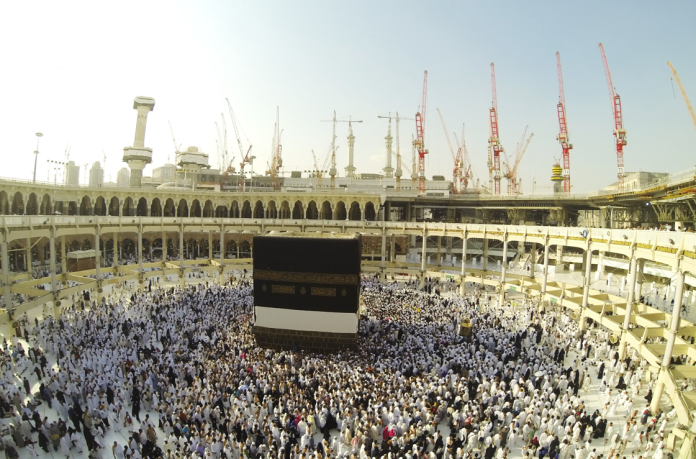Dozens of mainstream media outlets have run stories in the past week linking the heat related deaths during the annual Hajj in Saudi Arabia to climate change. There is no such connection. Data shows that Saudi Arabia has warmed less than half the global average during the recent period of warming, with no increase in average summer temperatures. In addition, deaths during the annual Hajj pilgrimage are common historically, and when they are related to heat stress they have factors in common, but climate change is not among them.
Axios, The Washington Post, the Associated Press, USA Today, and the New York Times, among dozens of other mainstream media outlets covered the more than 1,300 heat related deaths that occurred during the Hajj this year.
Some background is warranted. The Hajj is a mandatory religious pilgrimage that all adult Muslims who are physically and financially capable of undertaking the journey must make at least once in their lifetime. The Hajj consists in part of a number of physically demanding rituals, including long walks, standing on the desert plain from sunrise to sunset, and praying in the outdoors for extended periods of time. Published data indicates that between 2000 and 2019 the average number of Hajj pilgrims was 2,269,145 per year, of which nearly 70 percent came from outside Saudi Arabia, many from countries where more moderate temperatures are the norm.
Heatwaves, like the one experienced this year in Saudi Arabia, are common, rather than an uncommon feature of summer in the country. However, because the Islamic calendar is lunar and the Islamic year is between eleven and twelve days shorter than the Gregorian year, the date of Hajj changes from year to year, shifting 11 days earlier each year. As a result, summer pilgrimages during sustained highest temperatures, come in cycles.
The deaths of more than 1,300 people at this year’s Hajj attributed to heat is tragic, but historically not uncommon. Packing this many people into Mecca, a relatively small space results in mass deaths from different causes almost every year, including from stampedes, on occasion tens of thousands from disease outbreaks, protests, fires, and yes, heat prostration and heat stroke.
Some of the media coverage of these tragic deaths was better than others, but almost all falsely linked this year’s extreme heat and climate change. For example, the headline of Axios story covering the deaths was, “Hajj deaths highlight Saudi Arabia’s escalating climate-related health risks,” and a Washington Post headline opined, “Hajj heat wave deaths underscore climate threat for most vulnerable.”
The first bit of evidence debunking a link between this year’s heat related deaths during the Hajj and climate change is the fact that Saudi Arabia has not warmed that much during the recent period of warming. A fact sheet from the Kingdom of Saudi Arabia points out that the Kingdom is ranked as the 107th most vulnerable country to climate change. Concerning temperatures, during the recent period of modest warming, when the Earth as has experienced an average measured temperature increase exceeding 1.3℃ or more, Saudi Arabia has only warmed only an average of 0.4℃; less than 2/3 of the global average—an amount unnoticeable by people.
So while temperatures during this year’s Hajj have been extreme, it doesn’t reflect a trend which would provide a possible link to long-term climate change. This year’s heat is a weather event, not climate change.
Nor is the number of heat related illnesses and deaths unusual over the period of record keeping for the Hajj. During the Hajj’s “hot cycles,” the years when the Hajj takes place during Saudi Arabia’s summer months, heat related illnesses and deaths increase dramatically, by comparison to its “cold cycles.” During the 1982 through 1995 hot cycle, rates of heat stroke and heat exhaustion peaked at 134.2 and 858.8 per 100,000 pilgrims, peaking in August 1985, nearly 40 years of warming ago. In 1987, more than 1,000 heat stroke deaths were reported over the course of just a few days. In 2023, when the Hajj was 11 days later and deeper in the summer, at least 8,400 pilgrims were reported to have suffered from heat-related illnesses, although that number was likely low, since unless the case is severe, heat related illnesses often go unreported.
Going back further, in 1927, when the number of Hajj pilgrims was a fraction of the present number (approximately two to three percent), at least 1,500 pilgrims died of excessive heat – nearly 100 years of warming ago.
In short, neither the climate nor the fact of temperature related deaths have changed much in Saudi Arabia. The differences in the number of temperature related deaths between the Hajj’s hot and cold cycles are consistent.
In fact, research shows that it is less the heat itself that is responsible for the high number of heat related deaths and health events than the age and health of those participating in the Hajj. Research shows that most of the death during each Hajj hot cycle are among pilgrims from outside of the arid, hot Middle East. Older people and those with preexisting health conditions, especially when they come from countries with more temperate summer climates account for the vast majority of deaths. This fact was hinted at in a few stories covering the deaths, like the New York Times’ story which said, “Deaths at Hajj and big events, highlight failures to adjust to heat (emphasis author’s).
As a study in the journal, Environmental Health Perspectives noted:
[There is] better adaptation to heat among residents than among pilgrims. Elevated temperatures had an immediate strong and sustained effect on the mortality risk among pilgrims, but little change in risk among Mecca residents. Although neither hot nor cold temperatures were significantly associated with mortality risk for year-round residents, the team estimated that 71% of deaths among pilgrims could be attributed to elevated temperatures. This heat-attributable mortality is at least 40 times higher than previously reported in populations elsewhere.
The Kingdom of Saudi Arabia has not been slow to recognize and respond the dangers of heat related deaths during the Hajj, implementing a communication/warning system for pilgrims that come through official channels, providing air conditioned buses, planting trees for shade, developing and siting portable water stations and misting systems, air conditioning the Great Mosque of Mecca, and providing portable air conditioning systems for temporary tents, among other actions. Research shows these actions have contributed to a 74.6 percent decline in heat related incidences of stroke and a 47.6 percent drop in the heat related mortality rate compared to the prior 1982–1995 hot cycle, although heat related deaths still remain higher than during Hajj cool cycles.
Rather than hyping a non-existent connection between climate change and extreme summer heat in Saudi Arabia (a natural fact every summer) or Hajj related deaths, the mainstream media would serve the truth and its audience better by issuing warnings in advance of Hajj to potential pilgrims from temperate countries of the dangers of heat related illness and death when the Hajj is in a hot cycle, and informing them of the health and safety amenities the Saudi government has made available to make their Hajj journey safer.


















